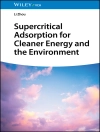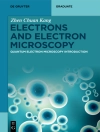Well-researched reference on stable alternative electrocatalysts and electrode materials with the potential to transform chemistry and processes in sensor- and energy-related technologies
Applied Polyoxometalate-based Electrocatalysis delivers an overview of the variety of efficient applications of free POM and POM-based (nano)composites as exciting materials in the field of electrocatalysis. With a variety of sizes, shapes, composition, and physical and chemical properties, these composites have important properties, such as the ability to undergo reversible multivalence reductions/oxidations, leading to the formation of mixed-valence species, which brings about favorable electrocatalytic properties with regard to several electrochemical processes.
Edited by a highly qualified independent researcher internationally recognized for her contributions to materials for electrochemical energy-related reactions, Applied Polyoxometalate-based Electrocatalysis includes information on:
- General methodologies used in the preparation of free POMs and POM-based nanocomposites and different strategies employed in electrode modification
- Role of POM-modified electrodes in oxidative and reductive electrocatalysis, including the detection/sensing of several (bio)molecules of interest and carbon dioxide electroreduction
- Application of POM-based (nano)composites, including the oxygen reduction reaction relevant to fuel cells, the oxygen and hydrogen evolution reactions, and batteries and supercapacitors
Applied Polyoxometalate-based Electrocatalysis is an essential reference on the subject for chemists, material scientists, chemical engineers, and institutions involved in work related to free POM and POM-based (nano)composites.
表中的内容
Part I Fundamentals 1
1 Introduction to Polyoxometalates 3
Daniela Flores and Carlos M. Granadeiro
1.1 Introduction 3
1.2 Polyoxometalate Structures 5
1.3 POM-based Composites and Materials 12
1.4 Conclusions 15
2 Design and Strategies to Enhance the Electrochemical Properties of POM Nanomaterials for Electrocatalysis 27
Adedayo Oghenenerhuvwu Dada, Kieran Dylan Jones, Darren Anthony Walsh, and Graham Neil Newton
2.1 Introduction 27
2.2 Design Approaches via Organofunctionalization 34
2.3 Conclusion 51
Part II Polyoxometalates for Oxidative Electrocatalysis 59
3 POM-based Electrocatalysts for L-Cysteine and NADH Oxidation 61
Israël Mbomekallé, Anne-Lucie Teillout, and Pedro de Oliveira
3.1 Introduction 61
3.2 The Electrocatalytic Oxidation of L-cysteine (Cys) 61
3.3 The Electrocatalytic Oxidation of Nicotinamide Adenine Dinucleotide (NADH) 76
3.4 Conclusion 85
4 POM-based Electrocatalysts for Pharmaceutical Molecules Oxidation 93
Diana M. Fernandes
4.1 Introduction 93
4.2 Preparation Methods of POM-based Films and (Nano)composites 94
4.3 POM-based Electrocatalysis 97
4.4 Conclusions 112
Part III Polyoxometalates for Reductive Electrocatalysis 123
5 POM-based Electrocatalysts for Inorganic Water Contaminants and Hydrogen Peroxide Reduction 125
Diana M. Fernandes
5.1 Introduction 125
5.2 Nitrite Reduction 126
5.3 Bromate Reduction 134
5.4 Iodate Reduction 138
5.5 Hydrogen Peroxide Reduction Reaction 142
5.6 Conclusions 145
6 POM-based Electrocatalysts for Carbon Dioxide Reduction 157
Bruno Fabre, Clément Falaise, and Emmanuel Cadot
6.1 Introduction 157
6.2 Thermodynamics of CO2 Reduction 158
6.3 Appealing Properties of POMs for CO2 Reduction 159
6.4 Coordination of CO2 by POM Compounds 164
6.5 Electrocatalytic Reduction of CO2 with Dissolved POMs 165
6.6 Electrocatalytic Reduction of CO2 at POMs-modified (Semi)conducting Electrode Surfaces 173
6.7 Conclusions 178
Part IV Polyoxometales for Fuel Cells and Electrolysers 183
7 POM-based Electrocatalysts for Oxygen Evolution Reaction 185
Víctor K. Abdelkader-Fernández, Pablo Garrido-Barros, Marta Nunes, and Marcos Gil-Sepulcre
7.1 Introduction: The OER Process 185
7.2 Pure POMs as OER Electrocatalysts 188
7.3 POM-containing (Nano)composites as OER Electrocatalysts 195
7.4 Heterogeneous Materials Derived from POM and POM-containing Nanocomposites 206
7.5 Concluding Remarks 209
8 POM-based Electrocatalysts for Hydrogen Evolution Reaction 219
Inês S. Marques, Renata Matos, and Diana M. Fernandes
8.1 Introduction: HER Process 219
8.2 Pure POMs as HER Electrocatalysts 221
8.3 Composite/Hybrid Materials 221
8.4 POM-derived Electrocatalysts 235
8.5 Concluding Remarks 252
9 POM-based Electrocatalysts for Oxygen Reduction Reactions 263
Henrique Araújo, Biljana Sljukic, and Diogo M.F. Santos
9.1 Introduction 263
9.2 Fundamentals of Oxygen Reduction Reaction 265
9.3 State-of-the-Art Electrocatalysts for the ORR 269
9.4 POM-based Electrocatalysts for the ORR 270
9.5 Conclusions 276
Part V Polyoxometales for Batteries and Supercapacitors 283
10 POM-based Nanomaterials for Battery Applications 285
Sanaz Taghaddosi and Ulrich Stimming
10.1 Introduction 285
10.2 Criteria for Efficient Redox Flow Batteries 286
10.3 Electrolyte Requirements for Redox Flow Batteries (RFBs) 289
10.4 Classification of POMs 292
10.5 Suitability of POMs for Energy Conversion and Storage Devices 295
10.6 Further Possibilities 313
10.7 POM-based RFBs in Comparison with Other RFBs 315
10.8 Conclusions 316
11 POM-based Nanomaterials for Supercapacitors 323
Ana C. Alves and Marta M. Alves
11.1 Introduction to Energy-storage Devices 323
11.2 Properties of POMs for Supercapacitors 326
11.3 Conclusions and Future Perspectives 351
Acknowledgements 352
References 352
Index 359
关于作者
Diana M. Fernandes, Ph D, is an independent researcher at LAQV-REQUIMTE where she created a new research line on materials for electrochemical energy-related reactions. The international relevance of her work is published in several journals. In 2015, she was awarded with the Young Investigator Award in Electrochemistry by the Portuguese Electrochemical Society (SPE).












